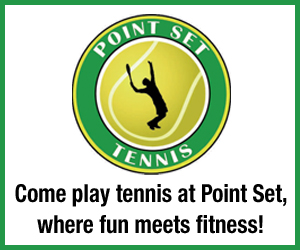Doubles Weapons: Communication

Last issue, I wrote an article on my favorite shot, “the cross-court lob,” as an awesome weapon to add to your arsenal in doubles. This issue, I am writing about a weapon that is a bit more abstract, but just as important. This issue’s doubles weapon of choice is “Communication.” Communication in doubles is vital, it’s necessary, and it’s not used half as much as it should. Some teams may talk about who will serve first, or who they want to play, but communication goes much further than just that and the more it’s utilized, the more of an advantage you give your team. Communication can be separated into verbal and non-verbal, but for the sake of brevity, I’m going to focus on just the verbal element. When talking about the verbal aspect of communication, we separate it into communication in points, in-between points, and those miscellaneous other times we use it.
Communication in points is most often used in order to work out who will take the ball. We hear things like “yours” and “mine” often while playing points. Honestly, I feel that in a game as fast as tennis that yours and mine are far too long to use. Instead, “you” and “me” are better alternatives. It may seem like a small detail, but in a point, a fraction of a second can mean hitting the ball early or hitting it late. If your team is not doing this, then it should be considered to add to your game. “You” and “me” is a great way to figure out who is going to take the ball when it’s in-between two players, but that doesn’t have to be the only time you use it. Even if the ball is obvious, it’s a good idea to use this form of communication. If you are saying you on a ball that is obviously your partner’s it may help them to be more alert and help them react faster ensuring better contact. If you say “me” when going for a ball that is obviously yours, it functions the same, helping you move to the ball sooner and getting you prepared mentally for making great contact.
Aside from who is going to take the ball, you can also use verbal communication to tell your partner where you are moving to or where you would like them to move. Here, we most commonly use the words “up” and “back.” We sometimes use the word “over,” but it’s less frequent. “Up” and “back” are just as important as “you” and “me” since if both players are in their appropriate positions, you are far more likely to win the point. In doubles tennis, it’s not uncommon for players to play the baseline for more shots than they should. It’s at this point that a player can help remind his partner that it’s time they move up. It should also be mentioned that as soon as one player recognizes that their situation has turned from offensive to defensive, they should communicate this to their partner by saying “back” as soon as possible. In points, the fractions of a second that you save by communicating with your partner pay dividends in quicker reactions, better shots and improved position.
Communication in-between points is just as important as communication in the point. In-between points, there’s a few things that a team should be talking about and considering. A few of the most important are:
►What has happened in the match (set, game) so far?
►Why has this happened?
►What should be done in reaction to this?
►What is our fallback if our opponents respond to our reaction?
This communication in-between points (games, sets) is vital. Success in tennis depends a great deal on being able to not over-think things and play the points from your gut, but that is only inside the point. Outside and in-between points is the time to work out strategies and tactics. Without this element, playing a match would be similar to building a house without blueprints. Talking to your partner helps the team play smarter, and playing smarter means the other team has to work harder.
Finally, there are times to use communication not just for the sake of communication, but for other reasons. There will be moments when the other doubles team will seem to be on fire, as if they cannot miss and are playing the match of their lives. It’s in moments like this that you should come together, not just to work out strategies, but additionally to try to break the rhythm of your opponents. If you do not communicate with your partner and just play the match going with the flow, it is more than likely the case that you’ll get beaten and beaten very quickly.
Communication can also be used to allow your partner or yourself to grab a quick breather. Have you ever been in a game that seemed to go 10 deuces long? Have you ever been in a game where you had a point go on and on for around 30 strokes? Times like this are a good time to come together and use communication to grab a quick breather. As a good partner, it’s your responsibility to know when your teammate needs that breather even if they don’t want to take it.
Lastly, communication is essential to help uplift your partner. Regardless if your teammate has missed seven consecutive shots or has double-faulted, staying positive and keeping your partner focused on the task at hand is a responsibility everyone has.
Communication separates veteran doubles players from those who are just starting. Whether you find yourself in the former, latter or somewhere in the middle, if you are not communicating, you are not doing as well as you could. Using communication effectively is just as important as a having a huge serve or a great volley and must be practiced just as much if not more.






